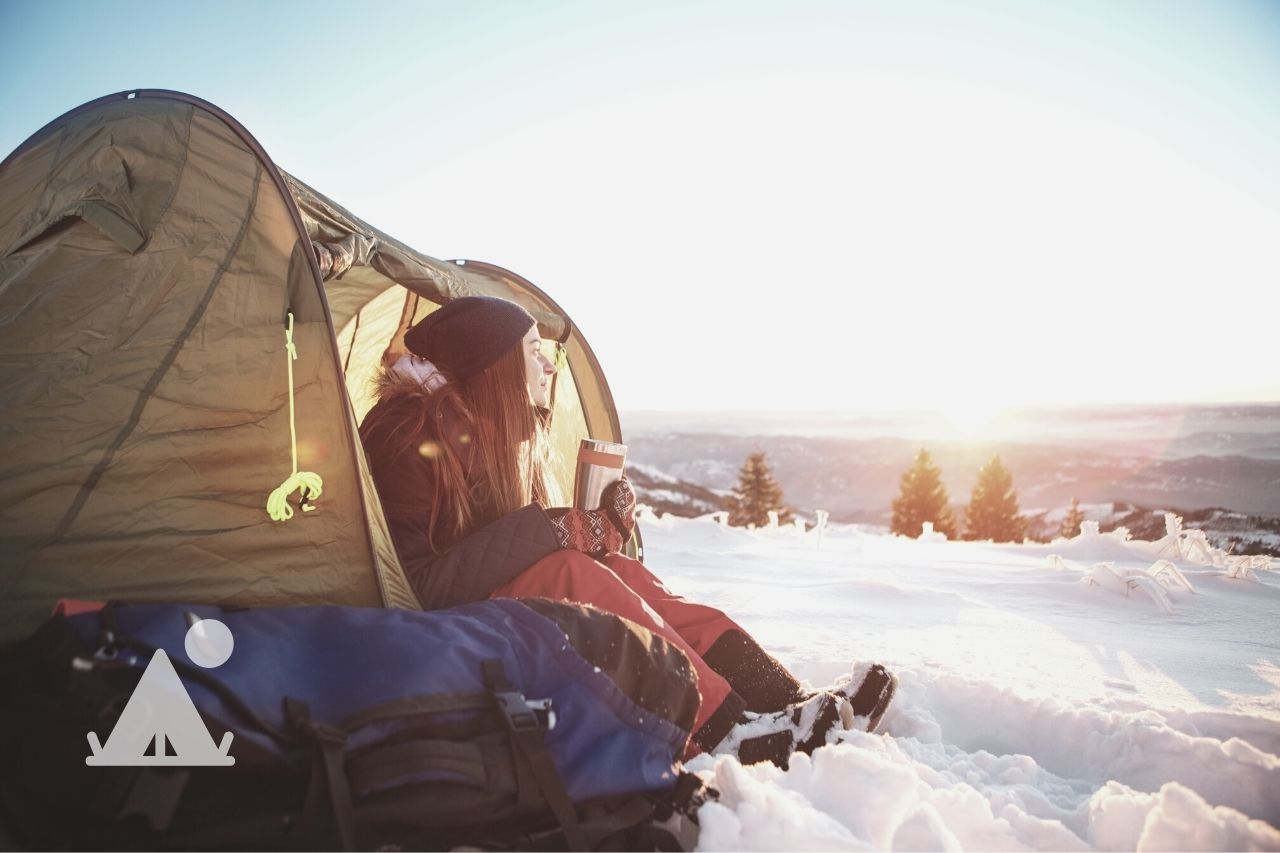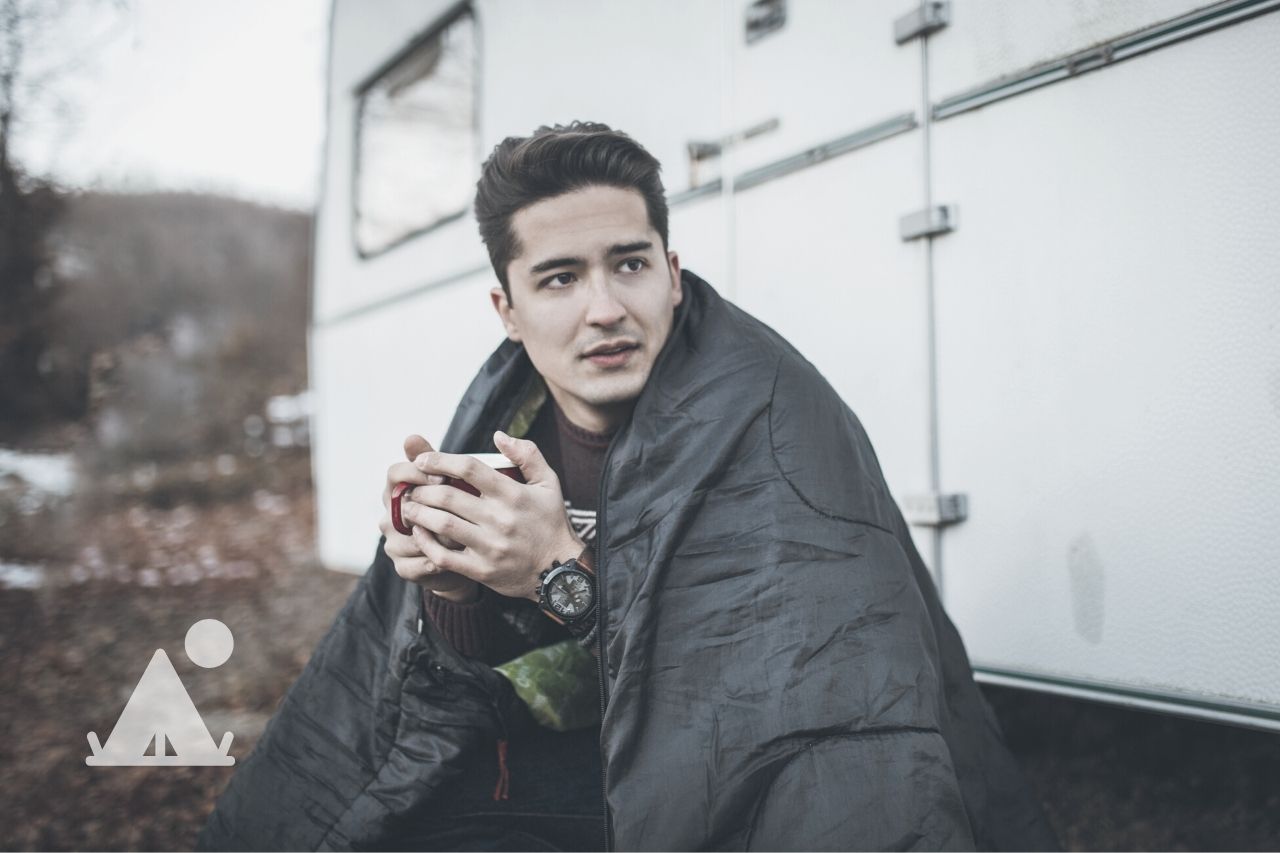How cold is too cold for tent camping depends on your tolerance for low temperatures, your camping experience and the kind of gear you have. While cold weather camping can be fun, it can also be dangerous if you are not well prepared.
What Is Considered Cold Weather Camping?

Different people have varying tolerance for cold. So what you may consider too chilly for camping is perfect outdoor weather for others.
But most people will consider nighttime temperatures in the low 40s and under to be cold. Any temperature starting from 40 going down counts as cold weather camping for many people.
But a majority of campers, even beginners, can tolerate nighttime temperatures in the high 30s and basic camping gear is usually enough for such conditions.
Some experienced campers take 32F (0C) as the proper start of cold weather camping. At this point, you need to have experience dealing with the cold and more advanced gear such as a 30 degree sleeping bag to brave a night in a tent outdoors.
Below 32F, we start getting into extreme winter camping. There are people who’ll take this to even colder extremes, camping in sub zero degree weather.
This requires specialized equipment and gear including a specific type of tent, high-insulation sleeping bag and sleeping pad, and most likely a heat source.
Here is also where hot tent camping comes in, where you essentially turn your tent into a cozy stove-heated cabin.
Note: We are talking specifically about tent camping. Car and truck campers can usually tolerate lower temperatures because the vehicle provides excellent shelter from snow, wind, and rain.
Something else to note is that, even if you can hack cold weather camping, it may not be as fun as you expect.
A lot of campers who’ve experienced temperatures below 30F say it was one of the most uncomfortable nights they’ve experienced.
If you really don’t enjoy cold weather, stick to summer and spring camping. After all, the goal of camping is to have fun.
Is Cold Weather Camping Dangerous?
If you know what to expect and you’ve adequately prepared yourself, cold weather camping is not that dangerous.
That said, it does carry more and bigger risks compared to warm weather camping like blizzards, unexpectedly cold temperatures, strong winds, and heavy snow or rain.
Experienced campers with the right gear know how to deal with such situations and are always ready for the worst.
But if you are not experienced in cold weather camping or don’t have the right equipment, cold weather camping can be deadly. Here are some of the biggest hazards to watch out for.
- Hypothermia, which occurs when you lose a lot of body heat quickly. This usually happens when you are exposed to cold temperatures while you are wet from rain or sweat.
- Frostbite happens when you are exposed to very cold temperatures, usually combined with wind.
- Winter dehydration is a real thing and can be harder to notice, making it more deadly. It usually happens when you sweat a lot and do not replenish with water. That’s why it’s crucial to keep drinking water and avoid sweating when camping in cold weather.
- Heavy snowfall when cold weather camping makes it easier to get lost. It’s harder to find your way and it’s also difficult for help to get to you.
- Cold weather can cause or exacerbate certain illnesses like asthma, lupus, and anemia. If you have a major health condition, the stress from cold weather exposure is probably not so good. Remember that it may be harder to get help in case of a health emergency. Clear with your doctor before you attempt winter camping.
How Cold Is Too Cold For Camping?
Now that you have an idea of what cold weather camping entails and the risks associated with it, how cold is too cold to go tent camping.
Here are some general recommendations.
- For beginners, only camp when night time temperatures are 50F or higher. Even if you can afford to get specialized cold weather gear, start with warmer weather and then gradually get into cold weather camping.
- At-risk campers with major health conditions may also want to stick to warm weather camping unless your doctor says it’s okay to camp in colder weather.
- Families camping with kids should also not go below 50F. Cold weather camping carries too many hazards for kids.
- If you feel you can tolerate some cold, but don’t want to freeze in your tent or get expensive gear, 40 to 50 degrees Fahrenheit is a sweet spot for most people who want to attempt cold weather camping.
- Think you are ready to tackle some serious winter camping? Start with a 32-40 camping trip, but be ready for temperatures to drop below 32. You’ll get an idea of how much cold you can tolerate and how well your current gear keeps you cozy and warm.
- As you gain experience camping in cold weather and learn what gear works best, you can attempt to camp in colder temperatures up to 0 degrees or less. You may need to seek places with harsh winters or visit high elevation camp sites.
How to Camp Safely In Cold Weather

1. Get the right gear for cold weather camping
You’ll need to rethink everything from the tent you are using down to the shoes you wear and the sleeping bag (don’t even try to go without one) you sleep in.
Here’s some of the essential gear you need for cold weather camping.
- A 4-season tent that can withstand heavy snowfall and strong winds.
- A sleeping bag rated for low temperatures. You can get sleeping bags rated for temperatures as low as -40F.
- A sleeping pad with a high R value, at least 3 for up to 32 degree camping and 4 or higher for extreme cold weather camping. The higher the R value, the warmer the sleeping pad will keep you.
- A sleeping bag liner to improve heat retention and insulation performance.
- Thermal underwear that keeps you warm while preventing sweating.
- An external tarp or rainfly for additional protection from rain and snow.
- Clothes and shoes rated for cold temperatures. Don’t forget thick socks, gloves, and warm headgear.
2. Get a heater
Your sleeping bag may be super cozy, but you won’t spend the entire camping trip asleep. For those moments you are resting in your tent, you’ll need to stay warm.
Dressing warm may not be enough in extreme cold. An additional heat source like a propane heater, an electric heater, or a stove can keep you safe and comfortable.
Just make sure you know how to safely use each type of heat source. For instance, if you get a propane heater, you also need a carbon monoxide alarm.
A stove heater (used in hot tent camping) needs to be set up to exhaust smoke and harmful gasses outside the tent. Here’s a video showing a basic hot tent setup.
You can also use a diesel heater, though that also requires proper exhaustion.
Adding a heat source to your tent allows you to camp in much colder temperatures. You can easily camp in sub zero temperatures and have fun.
3. Insulate your tent
Adding a ground tarp to your tent can make a big difference in how comfortable the tent is. The cold ground sucks a lot of heat from the tent.
Laying a tarp on it provides some insulation, especially when you are asleep.
Most 4-season tents are not insulated. They can withstand heavier snow and stronger winds, but they can feel pretty cold.
Consider adding insulation to your tent walls and roof. Bubble foil insulation works pretty well. The combination of the reflective surface and air insulation prevents heat loss from the tent.
Just make sure you maintain some ventilation to prevent condensation.
4. Dress properly
When you are out and about, dress in layers.
You should have bottom synthetic or wool layers that absorb sweat from your skin, mid layers that insulate you (a hoodie works great), and an outer layer that is waterproof (e.g. a shell jacket and waterproof rain pants).
For sleep, you want to only have one or two layers of clothes to avoid sweating. Fleece PJs or thermal underwear works great.
As long as you have the right sleeping bag and sleeping pad, you should be warm.
5. Be overprepared
Be prepared for any emergency when winter camping. This includes medical emergencies, equipment failure, getting stranded and so on.
Here are some preparedness tips.
- Pack a medical kit that includes an emergency blanket or full body warmers.
- Have a way to call for help and stay in contact with loved ones. This can be a satellite communicator or a personal locator beacon. Don’t rely on just your phone.
- Have a redundancy plan for the most crucial gear such as the heater. Carry a backup heat source even if it is a small electric heater or an electric blanket.
- Find out how to keep your vehicle and equipment working in cold temperatures. For example, you may need fuel treatment for your vehicle or a blanket to cover your power station.
- You’ll use a lot more firewood in cold weather. Carry more than you think you’ll need.
- Extensively study where you’ll be coming, including how to get there and the state of the roads.
- Closely follow weather reports to know what temperatures to expect and whether there are any emergency warnings.
- Get a sleeping bag rated for a lower temperature than you expect. Nighttime temperatures can dip below what was forecasted.
Finally, make sure your family or loved ones know about your plans including your destination, the route you’ll take, the vehicle you are driving, and how long you expect to be gone.